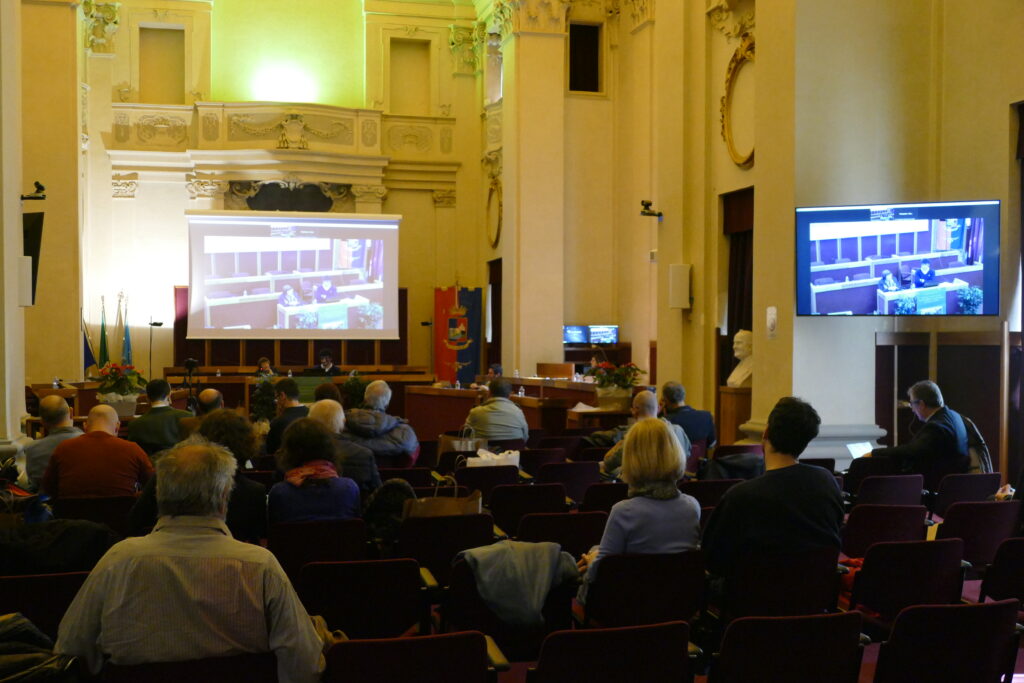The INA Assitalia Historical Archive for the Institute for the History of the Resistance and Contemporary Age of Forlì-Cesena
12 May 2023
The INA Assitalia Historical Archive participated in the national conference “Apparati e centri di potere nella Repubblica Sociale Italiana: politiche e conflitti” (apparatuses and centres of power in the Italian Social Republic: politics and conflicts), organised by the Istituto per la storia della Resistenza e dell’età contemporanea di Forlì-Cesena (institute for the history of the resistance and contemporary age of Forlì-Cesena), in partnership with the Istituto Nazionale Ferruccio Parri.
The research gathering, hosted in the province of Forlì’s council chamber on March 30-31 and April 1 2023, brought together historians and researchers from across Italy. The primary focus of the conference was to piece together the institutional aspects of the Italian Social Republic, the state entity created in Italy during the second phase of the Second World War, following the armistice of 8 September and Mussolini’s escape from the Campo Imperatore prison with the support of the Fascist forces of the Republican Fascist Party (PFR) and the occupying German forces, who had already flooded the Italian peninsula as part of Operation Achse.

The Italian Social Republic, known also as the Republic of Salò, has been the subject of significant academic interest, focused on its political and military apparatus, government dynamics, the management of its administration in times of war, the tensions and internal conflicts, its foreign affairs, relationships with the German allies-occupiers, the so-called “Jewish Question”, the role and functionality of the schools, the role of women, and last but not least, its self-image as depicted in propaganda.
The contribution of the INA Assitalia Historical Archive focused on the reconstruction of the corporate events of the Istituto Nazionale delle Assicurazioni (INA) and its affiliates (Le Assicurazioni d’Italia, Fiume, and Praevidentia) as an exemplary case study of institutions following the fall of the Fascist government. On 21 June, 1943, the BoD held its final meeting under the presidency of Giuseppe Bevione, a Fascist journalist and senator who had led the organisation since 1929. Following the fall of the Fascist regime on 25 July 1943, the first Badoglio government nominated as the new president a less politically aligned senator, Gaetano Scavonetti, and appointed Ignazio Giordani as chairman of the board. With the founding of the Italian Social Republic, the republican government replaced Badoglio’s appointments – even though Scavonetti and Giordani considered themselves still in post – and in February 1944 entrusted the management of the INA and its affiliates to a commissioner, Alberto Troilo. Under the instructions of the Ministry of Corporate Economy, Troilo coordinated the relocation of the headquarters of the institute from Rome – with a counter-relocation of the archives – first to Venice and then to Milan. To help with the task, Emilio Oldani was enlisted as director general. At the same time, in the south, with the approval of the Allies, the second Badoglio government put in post another commissioner (the third de facto), Alfredo De Liguoro. As the Anglo-American troops advanced, De Liguoro began to gradually take control of the INA’s structures from his offices in Naples.
